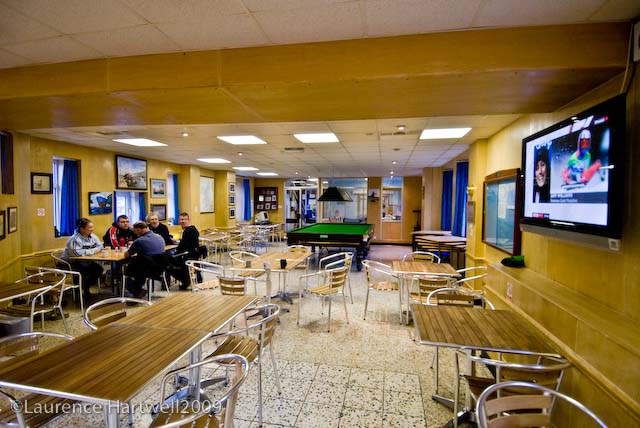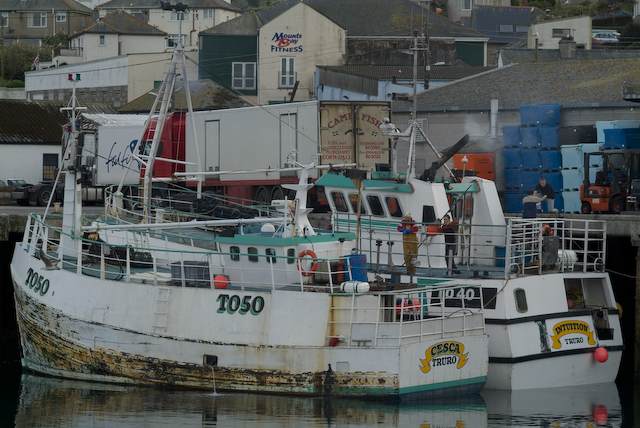Welcome to Through the Gaps, the UK fishing industry's most comprehensive information and image resource. Newlyn is England's largest fish market and where over 50 species are regularly landed from handline, trawl, net, ring net and pot vessels including #MSC Certified #Hake, #Cornish Sardine, handlined bass, pollack and mackerel. Art work, graphics and digital fishing industry images available from stock or on commission.
Tuesday 17 February 2015
Monday evening in the kind of light that made Newlyn so special for the Newlyn School of artists.
Once the sun drops below Chywoone Hill the sky is lit from below...
an effect that local marine artist Robert Jones has often captured in his work...
the Algrie gets to work on her trawls...
with both sides suspended the crew can get to the chain mats, trawl and stockings...
under that evening sky...
three fiths of the Rowse fleet are in port...
taking stone to the Scillys...
the William has at least one coat of fresh paint...
while she is laid up...
looks like highspeed broadband is heading down the quay...
under the sky...
the sardine boats wait to set sail for the night...
while the Ali-Cat still has a fair bit of work to do...
looking towards the Mount.
Monday 16 February 2015
Fishermen: the future of fisheries research? #GAP2IS
Fishermen: the future of fisheries research?
GAP2 International Symposium, Barcelona, February 24 – 26, 2015
Scientists, fishers and policy-makers will gather in Barcelona (24th-26th Feb) to take part in a pioneering symposium exploring how greater collaboration in fisheries research can contribute to the successful long-term future of fishing in the EU.
Watch presentations live!
 |
| Fishermen can visit the Mission in Newlyn on Feb 25th & 26th to watch on the TV and take part in the symposium via the internet - more information coming soon |
Entitled ‘Participatory Research and Co-Management in Fisheries’, the event is organised by European Commission funded project, GAP2. It will explore how fishers’ involvement in research can help to establish the knowledge-base for management measures that are fit-for-purpose.
Norwegian cod fisherman, Jan Andersen, comments on his hopes for the event: “This symposium will be a great opportunity to meet other fishermen who have been involved in research with scientists, and to meet policy-makers who determine our future as fishers. I am looking forward to presenting my experiences of collaboration, and to hear how it has worked in other fisheries in Europe. I am hopeful for the future of fishing".
Including fisher-only and policy-maker-only panels, and an innovative, interactive afternoon of the ‘GAP2 Great Exhibition’, the symposium will go beyond the traditional format of scientific conferences, and encourage active participation from all delegates.
A key feature of event will be a two-part workshop on ‘Co-management in the Mediterranean’, involving fishers, scientists, and high-level policy makers from across this key region. The workshop will address sustainability in the Mediterranean Sea, and explore co-management from different technical and policy perspectives.
The symposium as a whole will offer an opportunity for different groups of fisheries stakeholders, and regional, national, and international law-makers, to question each other on how they envision the future of fisheries in the EU, and how to overcome challenges to greater participation in fisheries research.
GAP2 Coordinator, Dr Steven Mackinson: "Scientists are waking up to the value of incorporating fishers' knowledge into the design and implementation of their research. This GAP2 event will be a fantastic opportunity for scientists from all over the world to hear first-hand from fishers, scientists and policy makers involved in participatory research how the process has worked for them, and what challenges they have faced."
Held against the backdrop of the Mediterranean Sea, the symposium aims to forge new partnerships for future research, and provide a collaborative forum in which all contributions are given equal credence.
Any journalists wishing the join the event are encouraged to attend on Tuesday 24th February, with a particular recommendation for the afternoon session, commencing 14:45 CET. The afternoon will feature the ‘GAP2 Great Exhibition’ – a creative centrepiece of the event, built around an informal, market-place style session. This will offer the best possible opportunity to view a range of participatory research projects, and interview delegates.
Delegate registrations for the GAP2 International Symposium are now closed, due to overwhelming interest.
For further information on the event, quotes or images, please contact Communications Manager, Katrina Borrow: Katrina@mindfullywired.org / +44 (0) 7935024100
**The attached image shows a scientist and a fisher from GAP2's Galicia case study giving their reasons for working together. Please feel free to use this, giving the credit indicated.
To keep up with the symposium as it’s taking place, follow @GAP2_Project / #GAP2IS.
Same sea, different pots, different ports, different boats, same lobster fishing
Apart from the difference in construction the means by which shellfish are fished for remains the same throughout the oceans of the world. In Newlyn the majority of shellfish boats work mainly parlour pots and fish for brown crab - lobsters are a welcome bycatch! A handful of small boats - like the Dreckly boys - fish specifically for lobsters using a handful of pots targeting very specific areas of ground in and around the Bay.
Here's how things are done across the other side of the pond on the East coast of the USA - watch how fish harvesters use traps submerged on the seafloor to catch Atlantic lobster, also known as American or Maine lobster. Traps are attached to lines and marked by floats on the surface. The traps attract lobster with bait and capture them live. Fish harvesters check their traps regularly to haul in their catch. This traditional fishing method has little impact on the seafloor and traps minimal bycatch or unwanted fish. This fishing method is used in Nova Scotia, New Brunswick, Prince Edward Island, Quebec, Newfoundland, Maine and Massachusetts.
For more info on Atlantic lobster, visit http://thisfish.info/fishery/species/...
For more info on lobster fishing visit: http://thisfish.info/fishery/atlantic...
CREDITS:
Producers: Goodforks
Editing: Blue Chip Productions
Videography: Kobb Media
Special thanks to the Canadian Council of Professional Fish Harvesters for providing video and photographs for the production of the video, and to Captain Victor Thibault and his crew.
Here's how things are done across the other side of the pond on the East coast of the USA - watch how fish harvesters use traps submerged on the seafloor to catch Atlantic lobster, also known as American or Maine lobster. Traps are attached to lines and marked by floats on the surface. The traps attract lobster with bait and capture them live. Fish harvesters check their traps regularly to haul in their catch. This traditional fishing method has little impact on the seafloor and traps minimal bycatch or unwanted fish. This fishing method is used in Nova Scotia, New Brunswick, Prince Edward Island, Quebec, Newfoundland, Maine and Massachusetts.
For more info on Atlantic lobster, visit http://thisfish.info/fishery/species/...
For more info on lobster fishing visit: http://thisfish.info/fishery/atlantic...
CREDITS:
Producers: Goodforks
Editing: Blue Chip Productions
Videography: Kobb Media
Special thanks to the Canadian Council of Professional Fish Harvesters for providing video and photographs for the production of the video, and to Captain Victor Thibault and his crew.
Monday's market at Newlyn.
Heads...
or tails...
which head...
a bit like a box of Cadbury's Allsorts, gurnard, mackerel and crab claws...
and more mackerel...
the supermodel of the fish world...
just a few of the 500+ boxes of hake form the Karewn of Ladram's maiden netting trip...
Dublin's best known chef Richard Corrigan's favourite fish...
back in the black...
no sign of the let up in cuttle landings this week...
safety at sea, the Karen's ablaze with deck lights...
as is her covered stern where the entire fleet of gill and trammel nets are kept...
laid to the market...
ahead of one of the port's few wooden netters left in the fleet...
keep on pallet trucking.
50 shades of grey in Mount's Bay
Saturday 14 February 2015
After the blow, a sunny Saturday with most of the fleet in port
Hundreds of miles of cliffs around the coast without a barrier in sight...
landing at the weekend...
close to the market...
gull's eye view of the IFCA boat...
most of the fleet are tied up today...
like the Tango twins...
time to go through the gear on the Billy Rowney...
and aboard the Sapphire II it's always tea time to keep the 'old man' of the fleet sweet....
before they get on with the gear again...
raised high...
landing doesn't stop...
setting up the shot...
room with a view...
could be Sicily...
across to the Mount...
the skies go grey.
Ex-Newlyn crabber Cesca sinks of Bardsey Island - crew safe and well.
 |
| The Cesca used to fish for the Rowse family crabbing fleet before being sold and was currently working out of Milford Haven. |
Flt Lt Al Conner of C Flight, 22 Squadron, RAF Valley told the Daily Post: “We went with the intention of delivering a pump to help them pump out but all four had abandoned to the liferaft.
“Flt Sgt Neil Cooper and winch operator Mike Bosier-Wyles got the men aboard, while pilot Wg Cmdr ‘Sparky’ Dunlop kept her steady, and we took them to hospital in Bangor. All the men were ok, although they were cold and wet.”
The crew of four of the "Cesca" was winched to safety from their sinking ship by Anglesey RAF rescuers on Feb 12, 2015. The fishing boat was quickly taking on water six miles south-west off Bardsey Island. When the fishermen reported the incident the boat’s pumps were coping but the crew soon realised that they would be safer abandoning their vessel into a liferaft as they waited for help to arrive. The ship had been underway up the Welsh coast from Milford Haven to Conwy. They phoned Holyhead Coastguard at 10.20 p.m. and were lifted out of a raft by a Seaking helicopter from RAF Valley.
The Porthdinllaen RNLI volunteers were also requested by the Coastguard to launch the lifeboat "John D Spicer" to the fishing boat off Bardsey Island. The lifeboat crew launched the all-weather lifeboat in force 6-7 winds, quickly making their way through big swells and rough seas towards the sinking vessel. As the volunteers were making their way to the scene the fishing boat had drifted and was now two miles north of the small island.
The RAF from Valley was also called to assist in the rescue and the fishermen were being winched to the rescue helicopter as Porthdinllaen lifeboat crew arrived on scene. The fishing boat had taken on too much water to be saved and Porthdinllaen RNLI volunteers stood by as a safety precaution as they waited for the fishing boat to sink. By 12:35 a.m. the fishing boat had sunk and the lifeboat crew made their way back to station, returning at 1:45 a.m.
Thanks to Timsen from VesselTracker
Subscribe to:
Posts (Atom)













































